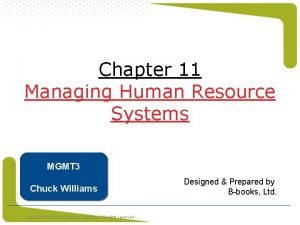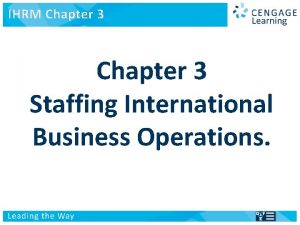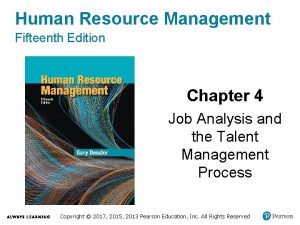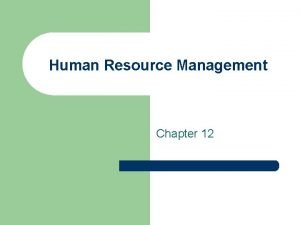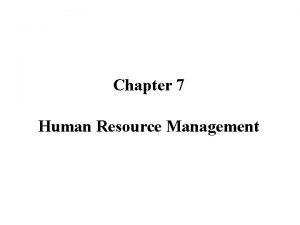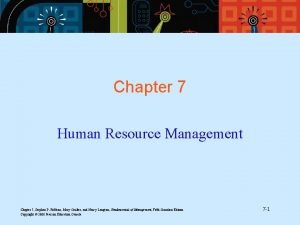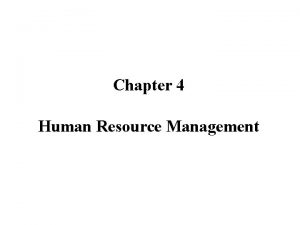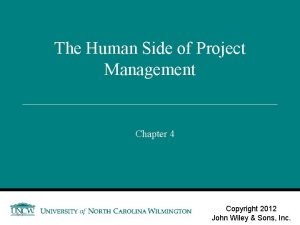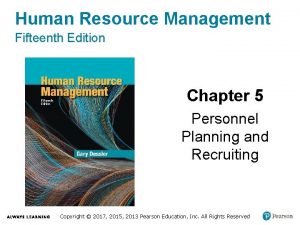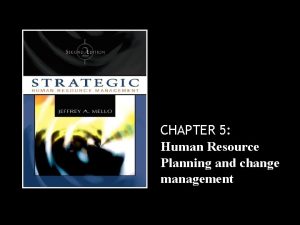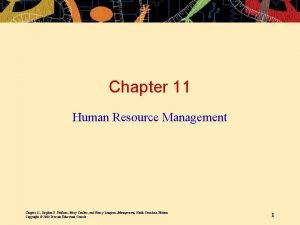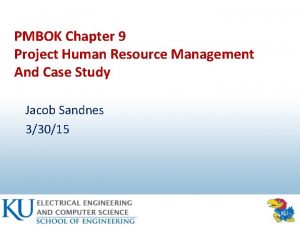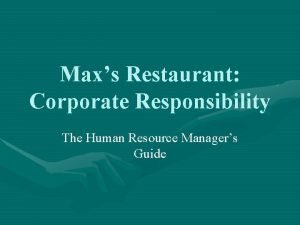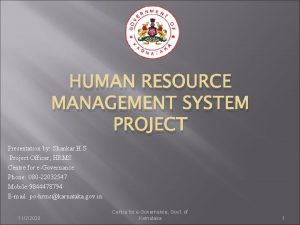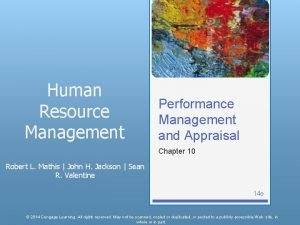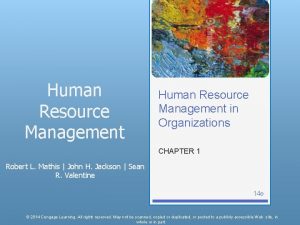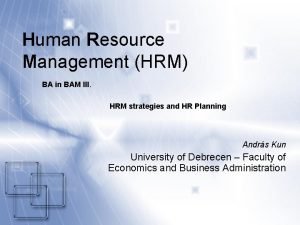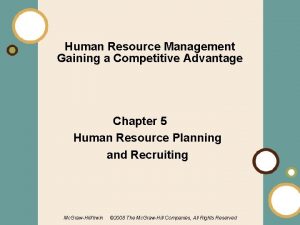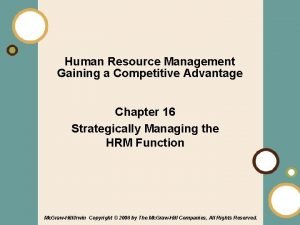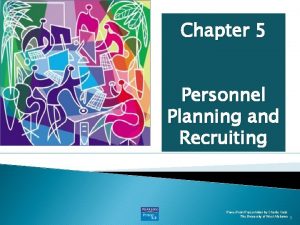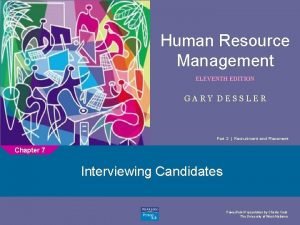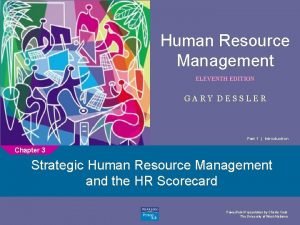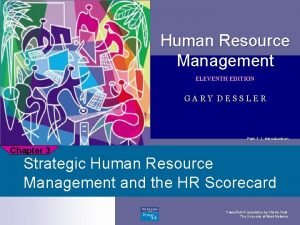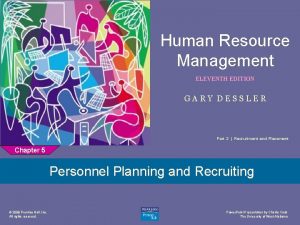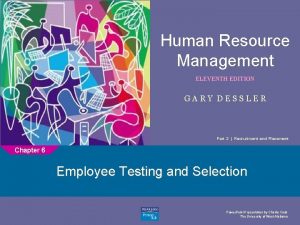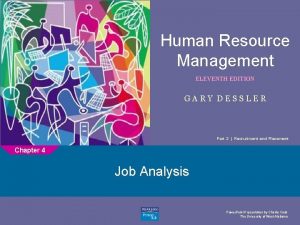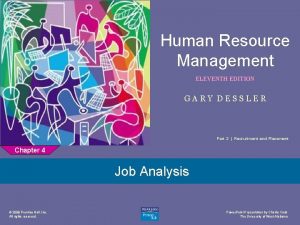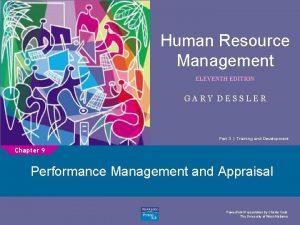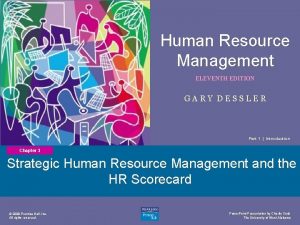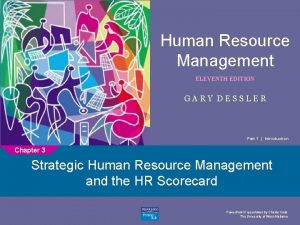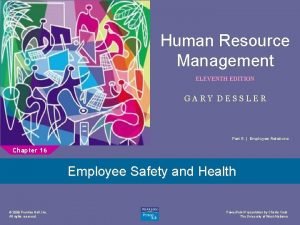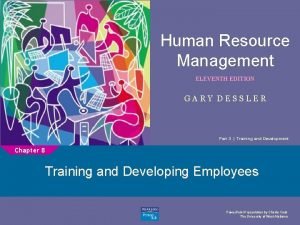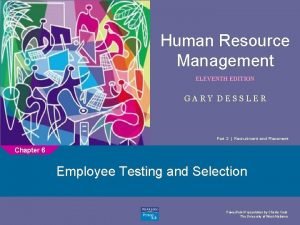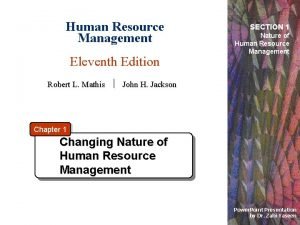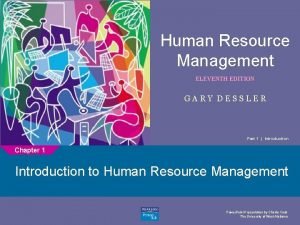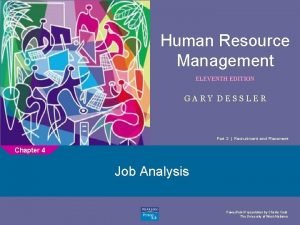Chapter 5 Human Resource Management 1 ELEVENTH EDITION














































- Slides: 46

Chapter 5 Human Resource Management 1 ELEVENTH EDITION Personnel GARY DESSLER Planning and Recruiting Power. Point Presentation by Charlie Cook The University of West Alabama 1

1. Explain the main techniques used in employment planning and forecasting. 2. List and discuss the main outside sources of candidates. 3. Effectively recruit job candidates. 4. Name and describe the main internal sources of candidates. 5. Develop a help wanted ad. 6. Explain how to recruit a more diverse workforce.

The Recruitment and Selection Process 1. 2. 3. 4. 5. Decide what positions to fill through personnel planning and forecasting. Build a candidate pool by recruiting internal or external candidates. Have candidates complete application forms and undergo initial screening interviews. Use selection tools to identify viable candidates. Decide who to make an offer to, by having the supervisor and others interview the candidates. 3

FIGURE 5– 1 Steps in Recruitment and Selection Process The recruitment and selection process is a series of hurdles aimed at selecting the best candidate for the job. 4

Planning and Forecasting Employment or Personnel Planning ◦ The process of deciding what positions the firm will have to fill, and how to fill them. Succession Planning ◦ The process of deciding how to fill the company’s most important executive jobs. What to Forecast? ◦ Overall personnel needs ◦ The supply of inside candidates ◦ The supply of outside candidates 5

6

Forecasting Personnel Needs Forecasting Tools Trend Analysis Ratio Analysis Scatter Plotting 7

Note: After fitting the line, you can project how many employees you’ll need, given your projected volume. Size of Hospital (Number of Beds) Number of Registered Nurses 200 240 300 260 400 470 500 600 620 700 660 800 820 900 860 FIGURE 5– 3 Determining the Relationship Between Hospital Size and Number of Nurses 8

Drawbacks to Traditional Forecasting Techniques They focus on projections and historical relationships. They do not consider the impact of strategic initiatives on future staffing levels. They support compensation plans that reward managers for managing ever-larger staffs. They “bake in” the idea that staff increases are inevitable. They validate and institutionalize present planning processes and the usual ways of doing things. 9

Using Computers to Forecast Personnel Requirements - DUH! Computerized Forecasts ◦ Software that estimates future staffing needs by: Projecting sales, volume of production, and personnel required to maintain different volumes of output. Forecasting staffing levels for direct labor, indirect staff, and exempt staff. Creating metrics for direct labor hours and three sales projection scenarios—minimum, maximum, and probable. 10

http: //www. quantrix. com

Issues of Privacy… 12

The Matter of Privacy Ensuring the Security of HR Information ◦ Control of HR information through access matrices ◦ Access to records and employee privacy Legal Considerations ◦ The Federal Privacy Act of 1974 ◦ New York Personal Privacy Act of 1985 ◦ HIPAA- The Health Insurance Portability and Accountability Act of 1996 (HIPAA) Privacy Rule -Regulates use of medical records ◦ Americans with Disabilities Act 13

Health Information Privacy

Understanding HIPPA 15

Since intruders can strike from outside an organization or from within, HR departments can help screen out potential identity thieves by following four basic rules: 1. Perform background checks on anyone who is going to have access to personal information. 2. If someone with access to personal information is out sick or on leave, don’t hire a temporary employee to replace him or her. Instead, bring in a trusted worker from another department. 3. Perform random background checks such as random drug tests. Just because someone passed five years ago doesn’t mean their current situation is the same. 4. Limit access to information such as SSNs, health information, and other sensitive data to HR managers who require it to do their jobs. Only on a “Need to Know basis!” 16

Centralized or Decentralized Recruiting and hiring… 17

Centralization vs. Decentralization The centralization of a staffing model is defined as the extent to which management has direct control over the staffing function. In a highly centralized staffing function, management may exercise control over strategy, resources, budget, and process. http: //www. ehow. com/info_8375742_adva ntages-disadvantages-decentralization. html In a decentralized staffing function, responsibility for the recruiting process is managed locally, with strategies and processes that are tailored to local circumstances. Both can co-exist…. 18

Advantages of Centralization ◦ Allows for sharing of applicant pools ◦ Strengthens employment brand ◦ Facilitates applying strategic priorities ◦ Reduces duplication of HR activities ◦ Reduces cost of new HR technologies ◦ Builds teams of HR experts ◦ Provides better measurement of HR performance ◦ “The corporate world heavily favors centralization: 59% of companies structure the staffing function on the centralized model, ” according to “ 2003 Recruiting Metrics and Performance Benchmark Report, by Staffing. org. 19

Advantages of Decentralization ◦ Decentralization involves spreading the decisionmaking throughout an organization instead of a few making all of the decisions. Decentralization is a matter of degree. At one end of the spectrum, a strongly decentralized organization has lowerlevel managers and employees making decisions. ◦ Decentralization provides lower-level managers with crucial experience in making decisions. Without this experience, they would not be prepared to act decisively when they are promoted into higher-level positions. ◦ 20

Internal Candidates 21

Finding Internal Candidates Rehiring Former Employees Job Posting Hiring from Within Succession Planning (HRIS) 22

Internal Candidates: Hiring from Within Advantages Foreknowledge of candidates’ strengths and weaknesses More accurate view of candidate’s skills Candidates have a stronger commitment to the company Increases employee morale Less training and orientation required Disadvantages Failed applicants become discontented Time wasted interviewing inside candidates who will not be considered Inbreeding strengthens tendency to maintain the status quo 23

Outside Candidates 24

Outside Sources of Candidates Locating Outside Candidates 1 Recruiting via the Internet 6 Executive Recruiters 2 Advertising 7 On Demand Recruiting Services (ODRS) 3 Employment Agencies 8 College Recruiting 4 Temp Agencies and Alternative Staffing 9 Referrals and Walk-ins 5 Offshoring/Outsourcing 25

Outside Sources of Candidates (cont’d) Recruiting via the Internet ◦ Advantages Cost-effective way to publicize job openings More applicants attracted over a longer period Immediate applicant responses Online prescreening of applicants Links to other job search sites Automation of applicant tracking and evaluation ◦ Disadvantages Exclusion of older and minority workers Excessive number of unqualified applicants Personal information privacy concerns of applicants 26

Outside Sources of Candidates (cont’d) Executive Recruiters (Headhunters) ◦ Contingent-based recruiters ◦ Retained executive searchers ◦ Internet technology and specialization trends Guidelines for Choosing a Recruiter 1. Make sure the firm is capable of conducting a thorough search. 2. Meet individual who will handle your assignment. 3. Ask how much the search firm charges. 4. Never rely solely on the recruiter to do reference checking. 27

Outside Sources of Candidates (cont’d) Employee Referrals ◦ Referring employees become stakeholders. ◦ Referral is a cost-effective recruitment program. ◦ Referral can speed up diversifying the workforce. ◦ Relying on referrals may be discriminatory. Walk-ins ◦ Seek employment through a personal direct approach to the employer. ◦ Courteous treatment of any applicant is a good business practice. 28

Outside Sources of Candidates (cont’d) College Recruiting ◦ On-campus recruiting goals To determine if the candidate is worthy of ◦ On-site visits further consideration Invitation letters To attract good Assigned hosts candidates Information packages Planned interviews Timely employment offer Follow-up ◦ Internships 29

http: //www. monster. com/

Craigs. List. . 31

FIGURE 5– 12 Note: Survey of 2, 294 organizations. Best Recruiting Sources Percentage of employers reporting best-performing sources for hiring without regard to cost, 2004. Source: Workforce Management, December 2004, p. 98. 32

FYI: Posting to the Web Find a Job Now: Resume. Rabbit Posts You On 85 Job Sites! 33

FYI: Building a Resume… Resume Development - Start here! 34

Employment Agencies….

Employment Agencies Types of Employment Agencies Public Agencies Nonprofit Agencies Private Agencies 36

37

Private Employment Agency Why Use a Private Employment Agency ◦ No HR department: firm lacks recruiting and screening capabilities. ◦ To attract a pool of qualified applicants. ◦ To fill a particular opening quickly. ◦ To attract more minority or female applicants. ◦ To reach currently employed individuals who are more comfortable dealing with agencies. ◦ To reduce internal time devoted to recruiting. 38

Avoiding Problems with Employment Agencies: ◦ Provide the agency with accurate and complete job descriptions. ◦ Make sure tests, application blanks, and interviews are part of the agency’s selection process. ◦ Review candidates accepted or rejected by your firm or the agency for effectiveness and fairness of agency’s screening process. ◦ Screen agency for effectiveness in filling positions. ◦ Supplement the agency’s reference checking by checking the final candidate’s references yourself. 39

Temp Agencies and Alternative Staffing Benefits of Temps: ◦ Increased productivity—paid only when working ◦ Allows “trial run” for prospective employees ◦ No recruitment, screening, and payroll administration costs Costs of Temps: ◦ Increased labor costs due to fees paid to temp agencies ◦ Temp employees’ lack of commitment to the firm 40

Concerns of Temp Employees Dehumanizing, impersonal, and discouraging treatment by employers. Insecurity about employment and pessimism about the future. Worry about the lack of insurance and pension benefits. Being misled about job assignments and whether temporary assignments are likely to become full-time positions. Being “underemployed” while trying return to the full-time labor market. Anger toward the corporate world and its values; expressed as alienation and disenchantment. 41

FIGURE 5– 11 Guidelines for Using Temporary Employees 1. Do not train your contingent workers. Ask their staffing agency to handle training. 2. Do not negotiate the pay rate of your contingent workers. The agency should set pay. 3. Do not coach or counsel a contingent worker on his/her job performance. Instead, call the person’s agency and request that it do so. 4. Do not negotiate a contingent worker’s vacations or personal time off. Direct the worker to his or her agency. 5. Do not routinely include contingent workers in your company’s employee functions. 6. Do not allow contingent workers to utilize facilities intended for employees. 7. Do not let managers issue company business cards, nameplates, or employee badges to contingent workers without HR and legal approval. 8. Do not let managers discuss harassment or discrimination issues with contingent workers. 9. Do not discuss job opportunities and the contingent worker’s suitability for them directly. Instead, refer the worker to publicly available job postings. 10. Do not terminate a contingent worker directly. Contact the agency to do so. Source: Adapted from Bohner and Selasco, “Beware the Legal Risks of Hiring Temps, ” Workforce, October 2000, p. 53.

Working with a Temp Agency Invoicing. Make sure the agency’s invoice fits your company’s needs. Time sheets. The time sheet is a verification of hours worked an Temp-to-perm policy. What is the policy if you want to hire a temp as a Recruitment of and benefits for temp employees. How does the agency Dress code. Specify the attire at each of your offices or plants. Equal employment opportunity statement. Get a statement from the Job description information. Ensure that the agency understands the job agreement to pay the agency’s fees. permanent employee? plan to recruit and what sorts of benefits it will it pay? agency that it does not discriminate when filling temp orders. to be filled and the sort of person you want to fill it. 43

Offshoring/Outsourcing White. Collar and Other Jobs Political and Military Instability Resentment and anxiety of U. S. employees/unions Costs of foreign workers Special training of foreign employees Cultural Misunderstandings Main Issues Customers’ security and privacy concerns Foreign contracts, liability, and legal concerns 44

Application Forms and the Law Education Achievements Arrest Record Housing Arrangements Areas of Personal Information Marital Status Physical Handicaps Notification in Case of Emergency Memberships in Organizations 45

KEY TERMS employment or personnel planning trend analysis ratio analysis scatter plot computerized forecast qualifications inventories personnel replacement charts position replacement card recruiting yield pyramid job posting succession planning alternative staffing on demand recruiting services (ODRS) application form 46
 Eleventh edition management
Eleventh edition management Management eleventh edition stephen p robbins
Management eleventh edition stephen p robbins Management eleventh edition
Management eleventh edition Management eleventh edition
Management eleventh edition Human resources department structure
Human resources department structure Gary dessler human resource management
Gary dessler human resource management International human resource management dowling 6th edition
International human resource management dowling 6th edition Performance appraisal in human resource management
Performance appraisal in human resource management Indebtedness and deregulation in hrm
Indebtedness and deregulation in hrm Time management in human resource management
Time management in human resource management Assess human resource requirements of a retail organization
Assess human resource requirements of a retail organization Management is universal and everywhere
Management is universal and everywhere Human resource management chapter 2
Human resource management chapter 2 Chapter 9 human resource management
Chapter 9 human resource management Chapter 11 human resource management
Chapter 11 human resource management Chapter 1 introduction to human resource management
Chapter 1 introduction to human resource management Intro to human resource management
Intro to human resource management Human resource management lecture chapter 1
Human resource management lecture chapter 1 Determinants of staffing choices
Determinants of staffing choices Human resource management chapter 4
Human resource management chapter 4 Chapter 12 human resource management
Chapter 12 human resource management Chapter 7 human resource management
Chapter 7 human resource management Chapter 7 human resource management
Chapter 7 human resource management Human resource management chapter 4
Human resource management chapter 4 Human side of project management
Human side of project management Example of replacement chart
Example of replacement chart Human resource management chapter 5
Human resource management chapter 5 Chapter 11 human resource management
Chapter 11 human resource management Chadha committee
Chadha committee Eleventh 5 year plan
Eleventh 5 year plan Eleventh plan
Eleventh plan For his eleventh birthday elvis presley
For his eleventh birthday elvis presley Resource management pmp
Resource management pmp Human resource management pmbok
Human resource management pmbok Importance of human resource managment
Importance of human resource managment Human resource management in restaurants
Human resource management in restaurants Purpose of induction
Purpose of induction Human resource management system project ppt
Human resource management system project ppt Mbo performance appraisal method
Mbo performance appraisal method Current issues in human resource management
Current issues in human resource management Ba human resource management
Ba human resource management Identify job vacancy
Identify job vacancy Human resources management gaining a competitive advantage
Human resources management gaining a competitive advantage Human resource management gaining a competitive advantage
Human resource management gaining a competitive advantage Human resource management gaining a competitive advantage
Human resource management gaining a competitive advantage Human resource management questions for exams
Human resource management questions for exams Human resource management strategy and analysis
Human resource management strategy and analysis














